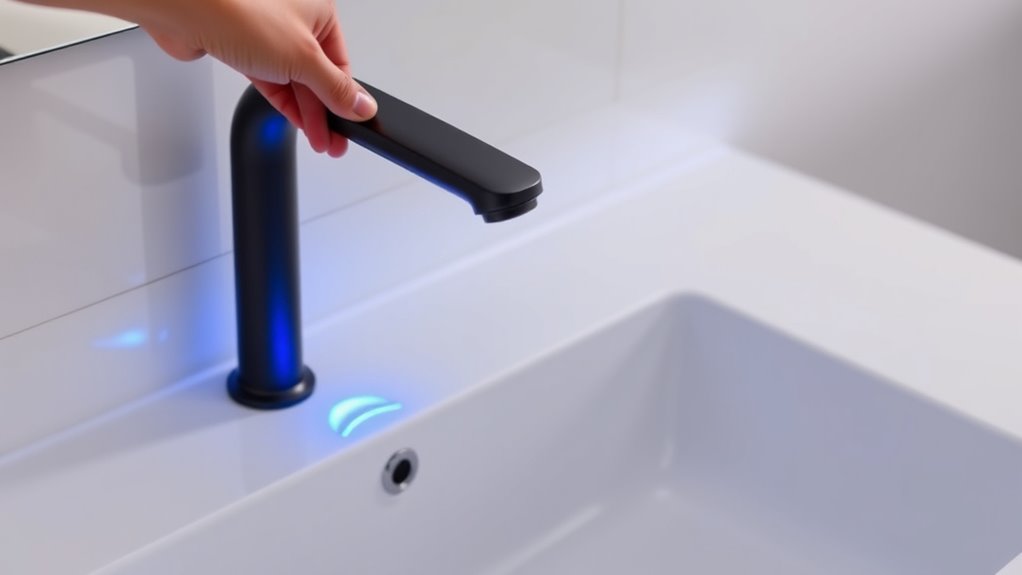Smart faucets use sensors like infrared and ultrasonic to detect your hands without touch. Infrared sensors sense heat signatures, while ultrasonic sensors detect motion via sound waves. When your hands are in range, the sensors send signals to electronic components that activate the valve, releasing water. These systems guarantee hygiene, conserve water, and improve convenience. If you want to understand how these sensors work together, keep exploring how technology makes it all possible.
Key Takeaways
- Touchless sensors like infrared, ultrasonic, and capacitive detect hand presence or heat signatures to activate water flow.
- Infrared sensors sense temperature differences, while ultrasonic sensors detect motion through sound wave reflections.
- Electronic components, including microcontrollers, process sensor signals to determine when to open or close the faucet valve.
- Signal processing techniques filter noise and recognize deliberate gestures, ensuring reliable and accurate activation.
- The sensors work together to provide hygienic, water-saving, and contactless operation of smart faucets.
Types of Sensor Technologies in Smart Faucets
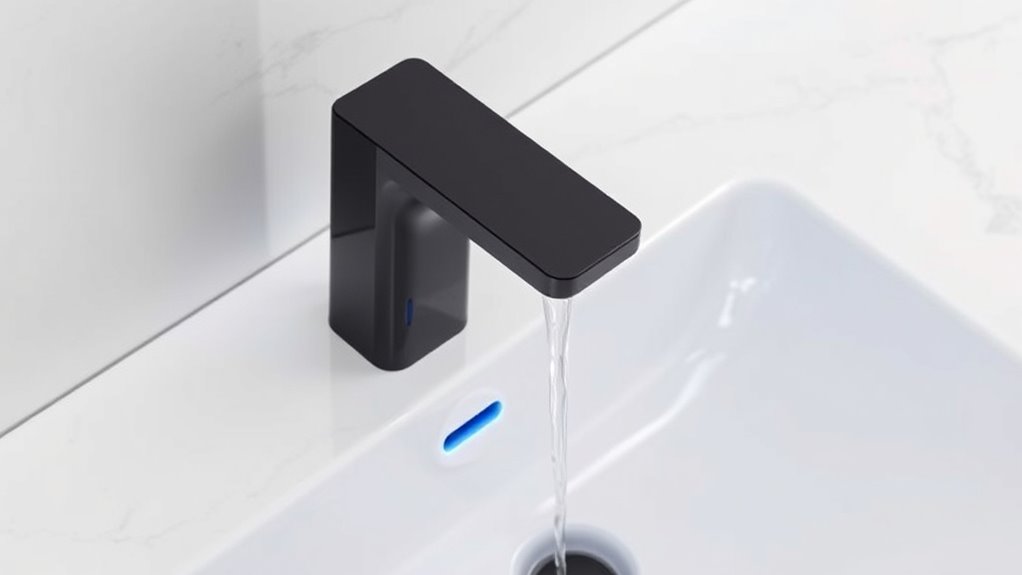
Smart faucets utilize a variety of sensor technologies to detect user presence and control water flow automatically. These sensors include ultrasonic, infrared, and capacitive types. Ultrasonic sensors use sound waves to sense movement or proximity, allowing the faucet to activate when you’re nearby. Infrared sensors detect heat signatures or body heat to trigger water flow, though this will be discussed more in detail later. Capacitive sensors sense changes in electrical fields caused by your hand’s touch or proximity. Each technology offers different advantages in accuracy, response time, and power consumption. They work seamlessly to provide a hygienic, hands-free experience, reducing water waste and minimizing germ transfer. Sensor technology improves the responsiveness and efficiency of smart faucets. Understanding these sensor types helps you choose the right smart faucet for your needs. Additionally, advancements in sensor accuracy continue to enhance user experience and energy efficiency. Moreover, ongoing innovations in power management ensure these sensors operate effectively while conserving energy.
Infrared Sensors and How They Detect Hands
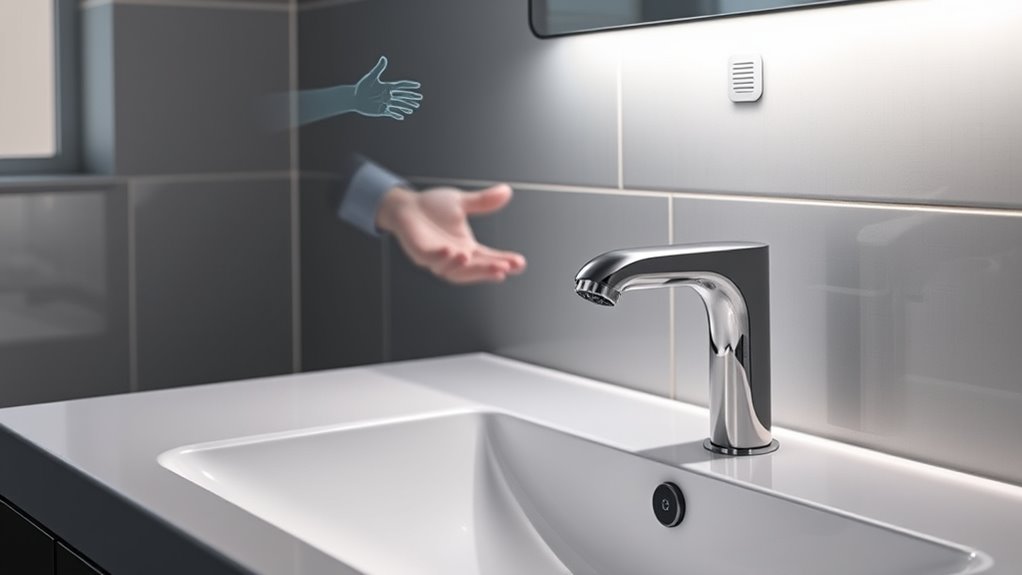
Infrared sensors detect your hands by sensing heat signatures or changes in infrared radiation emitted by your body. When you move your hand near the faucet, the sensor picks up the infrared energy difference, triggering the water flow. This process involves three key steps:
Infrared sensors detect hands by sensing heat signatures, triggering water flow seamlessly and hygienically.
- The sensor continuously monitors the environment for infrared radiation variations.
- When your hand enters the detection zone, it causes a measurable change in infrared emission.
- The sensor processes this change and signals the valve to open, allowing water to flow. Infrared sensors for touchless operation are designed to respond specifically to heat differences rather than physical contact, enabling seamless, hygienic operation. This technology ensures water activates only when your hand is present, conserving water and enhancing convenience. Additionally, automation technology in faucets can be integrated with smart home systems for improved control and efficiency, often utilizing smart home integration features.
Ultrasonic Sensors and Their Role in Water Activation
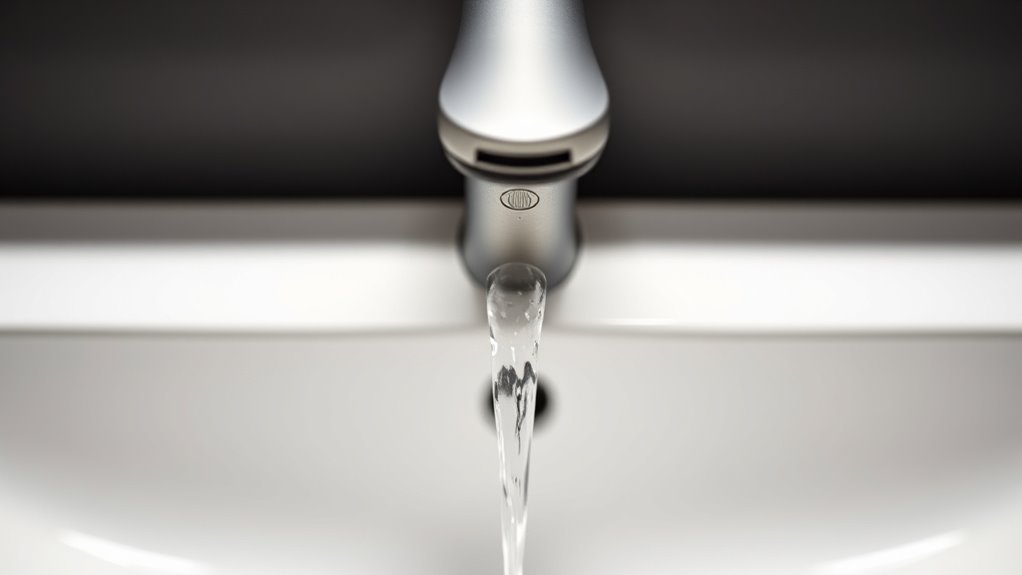
Ultrasonic sensors detect motion by sending high-frequency sound waves and measuring the reflections that bounce back. These signals are processed by integrated circuits to determine if your hand is nearby. When motion is detected, the sensor triggers the water activation system seamlessly. Additionally, understanding the signs of spoilage can help ensure the freshness of water or other liquids used in your smart faucet system. Incorporating Kia Tuning techniques can optimize the system’s responsiveness and durability for various environments. As AI advancements continue, integrating on-device AI capabilities can further enhance sensor accuracy and efficiency.
How Ultrasonic Sensors Detect Motion
Ultrasonic sensors detect motion by emitting high-frequency sound waves and interpreting the echoes that bounce back. When your hand moves within the sensor’s range, it reflects these sound waves differently than static objects. The sensor then analyzes these changes to determine motion. To understand how this works, consider:
- The sensor continuously sends out ultrasonic pulses at a specific frequency.
- These pulses hit objects or your hand and bounce back as echoes.
- The sensor measures the time it takes for echoes to return and detects changes in distance or position.
- The sensor’s internal processing adjusts sensitivity to ensure accurate detection under varying conditions.
- The use of natural materials can influence how sound waves reflect, affecting sensor performance and placement.
- Proper placement and calibration are essential to optimize sensor accuracy and prevent false triggers.
- Advances in sensor technology have improved the reliability and responsiveness of touchless faucets, making them more convenient and efficient.
This real-time analysis enables the sensor to recognize movement accurately. The process happens rapidly, allowing your faucet to respond instantly when you approach or move away, making water flow seamlessly without contact.
Signal Processing Mechanisms
Signal processing mechanisms are essential for turning the raw echoes from sensors into actionable signals that activate water flow. Ultrasonic sensors emit sound waves and detect their echoes reflected from nearby objects. These echoes are complex signals requiring analysis to determine presence and distance. The processing system filters noise, analyzes signal patterns, and calculates the object’s position. This step ensures accurate detection before triggering the faucet. Here’s a quick overview:
| Signal Type | Purpose | Outcome |
|---|---|---|
| Raw Echoes | Initial sensor response | Basic sound wave data |
| Filtered Data | Remove noise and interference | Clearer signals |
| Processed Signal | Confirm object detection | Activation command |
Efficient processing guarantees that your faucet responds swiftly and accurately to your hand movement. Additionally, signal processing techniques help minimize false triggers, ensuring reliable operation.
Water Activation Triggers
Water activation triggers in smart faucets rely heavily on ultrasonic sensors, which detect the presence of your hand or object nearby. These sensors emit high-frequency sound waves and analyze the echoes reflecting back from objects. When your hand enters the sensor’s range, it causes a change in the reflected signals, prompting the faucet to turn on. To understand this better, consider:
- Detection Range: Ultrasonic sensors can detect objects within a specific distance, typically a few centimeters to several inches.
- Signal Processing: The sensor’s circuitry interprets changes in echo patterns to confirm the presence of an object. This process involves sophisticated signal analysis that ensures accuracy and reduces false triggers.
- Activation Response: Once confirmed, the faucet’s valve opens, delivering water, and closes once the object is removed.
- Methodology: This technology is a practical application of principles from Ethical Hacking, ensuring secure and reliable operation of smart devices.
- Integration: Additionally, ultrasonic sensors are often integrated with AI analytics to optimize performance and responsiveness in smart faucet systems.
The Electronic Components Powering Touchless Operation

To enable touchless operation, smart faucets rely on a variety of electronic components that detect your presence and activate the water flow automatically. At the core are sensors, typically infrared or ultrasonic, which continuously monitor the faucet area for motion or heat signatures. These sensors convert detected signals into electrical data that indicate whether someone is nearby. A microcontroller or processor then interprets this data, determining if activation criteria are met. Powering these components are small, efficient power sources like batteries or direct electrical connections. Additionally, circuit boards integrate the sensors and controllers, ensuring smooth communication between parts. All these components work together seamlessly, enabling your faucet to respond quickly and accurately to your presence without manual intervention.
How Sensors Process Signals to Activate Water Flow
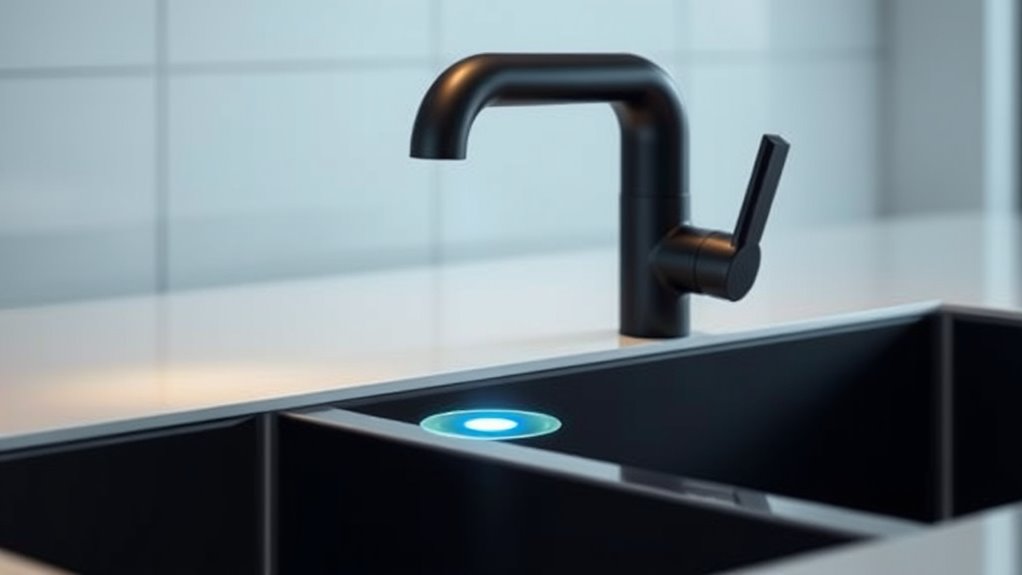
When a sensor detects your hand, it sends a signal that needs to be precisely interpreted. You’ll learn how various detection methods and processing techniques work together to determine when to turn the water on or off. Finally, the system controls the valve to guarantee smooth, responsive water flow based on these signals.
Signal Detection Mechanisms
Sensors in smart faucets detect signals from user proximity or touch to determine when to activate the water flow. These sensors interpret different types of signals to make quick, accurate decisions. Typically, the detection mechanisms include:
- Infrared sensors that sense heat from your hands or body, triggering activation when motion is detected within a certain range.
- Capacitive sensors that identify changes in electrical charge caused by your touch or proximity.
- Ultrasonic sensors that measure distance by bouncing sound waves off your hands, activating when the object is within a set distance.
These mechanisms work seamlessly to ensure water flows only when needed, conserving water and enhancing hygiene by minimizing contact. Understanding these detection types helps you grasp how smart faucets respond instantly to user presence.
Signal Processing Techniques
Once sensors detect a signal indicating your presence or touch, they begin processing that information to determine whether to activate the water flow. They use algorithms to analyze the raw data, filtering out noise or false signals caused by ambient light or movement. Signal processing techniques like threshold detection help decide if the input surpasses a preset level, indicating a genuine user presence. Some sensors implement digital filtering, such as low-pass filters, to smooth out rapid fluctuations and improve accuracy. Pattern recognition algorithms may also be used to distinguish intentional gestures from accidental ones. By refining these signals, the system reduces false activations and guarantees water flows only when intended. This processing step is vital for responsive, reliable operation of touchless faucets.
Actuation and Control
Actuation and control systems interpret the processed signals from sensors to determine whether to activate the water flow. When a sensor detects your hand nearby, the control unit evaluates the signal based on predefined criteria. This decision-making process involves several steps:
- Signal Verification: The system confirms the sensor’s input is valid and consistent.
- Decision Logic: It applies algorithms to decide if water should flow, considering factors like proximity or duration.
- Actuator Activation: If conditions are met, the control module triggers the valve to open, allowing water to flow.
This seamless coordination ensures water is only activated when needed, reducing waste and enhancing hygiene. Your faucet’s control system acts as the smart brain, translating sensor inputs into precise, automated water delivery.
Benefits of Sensor-Based Control in Daily Use
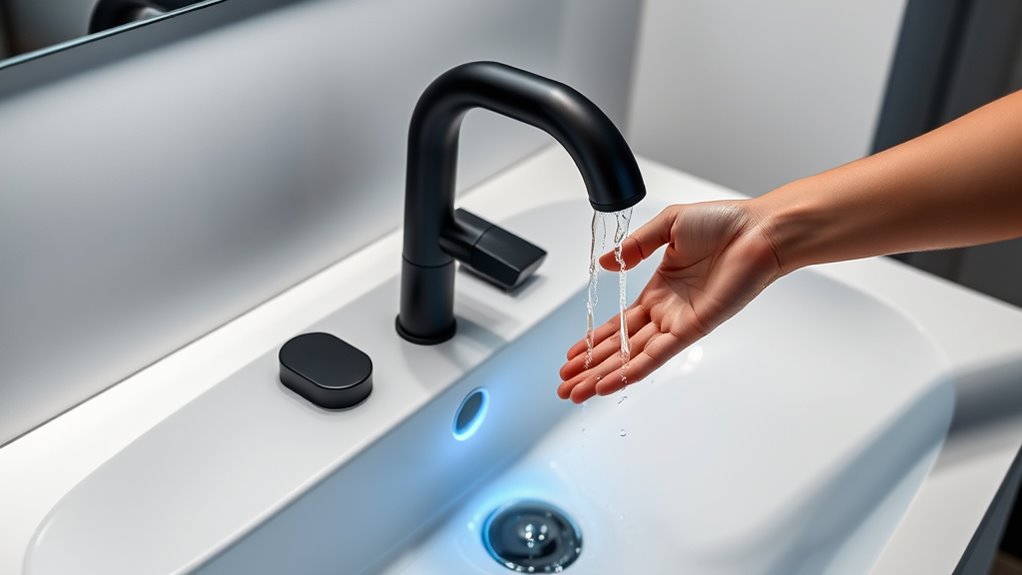
Sensor-based control in smart faucets offers numerous benefits for daily use, making tasks more efficient and hygienic. With touchless operation, you don’t need to turn knobs or handle surfaces, reducing contact with germs and dirt. This feature is especially helpful when your hands are messy or full. It also conserves water by automatically shutting off once you stop rinsing or washing. You’ll notice improved convenience, as water flows instantly when needed and stops precisely when you remove your hands. Additionally, sensor control minimizes wear and tear on faucet parts, extending their lifespan. Overall, this technology enhances cleanliness, saves water, and streamlines your daily routines, offering a more hygienic and eco-friendly experience every time you use your faucet.
Future Developments in Touchless Faucet Technology
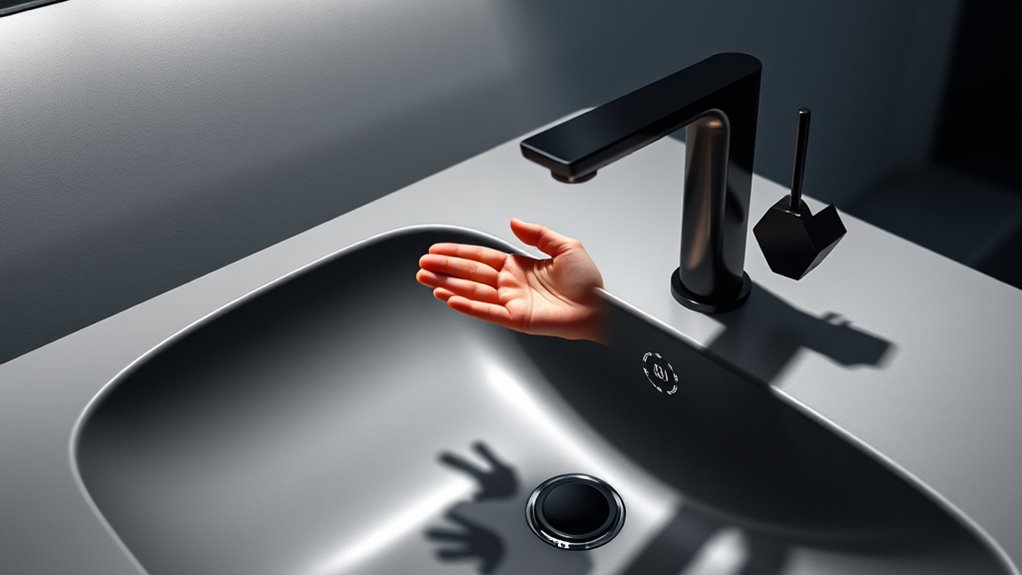
How will future innovations shape touchless faucet technology? Advances will make sensors smarter, more responsive, and energy-efficient. You can expect several key developments:
- Enhanced sensors that differentiate between users and objects, reducing false activations.
- Integration with smart home systems for remote control and automation, allowing you to customize water flow and temperature via apps.
- Improved energy efficiency through adaptive power management, extending battery life and reducing environmental impact.
These innovations will make touchless faucets more intuitive, reliable, and eco-friendly. As technology evolves, you’ll benefit from increased convenience, hygiene, and sustainability. Future designs will blend seamlessly into modern spaces, elevating your daily routines with smarter, more efficient solutions.
Frequently Asked Questions
How Durable Are Sensor Components in Everyday Use?
You wonder about the durability of sensor components in everyday use. Generally, these sensors are built to last, with many designed to withstand frequent activation and exposure to water, dirt, and cleaning agents. High-quality sensors use robust materials and protective coatings, making them resistant to wear and corrosion. However, like any electronic component, they can eventually degrade over time, especially if not properly maintained or if exposed to harsh conditions.
Can Touchless Faucets Be Manually Operated During Power Failures?
During power failures, you can usually operate touchless faucets manually. Most models include a manual override feature, like a lever or a switch, allowing you to turn the water on and off without the sensor. Check your faucet’s specific instructions, but generally, this backup method guarantees you don’t lose access to water when the power goes out. This way, you stay functional even during emergencies.
Are There Health Concerns Associated With Sensor-Based Water Systems?
You might wonder if sensor-based water systems pose health risks. Generally, these systems are safe because they use sanitized water and have built-in filters. However, there’s a small chance of bacteria buildup in sensors or valves if not maintained properly. To stay safe, you should clean and service your faucet regularly, and guarantee the system meets health standards. Proper upkeep minimizes any potential health concerns.
How Energy-Efficient Are These Sensor Systems Compared to Traditional Faucets?
Imagine you’re in a sci-fi movie, and smart sensors save water and energy. These systems are more efficient than traditional faucets because they only activate when needed, reducing waste. You’ll notice lower water bills and energy use since sensors turn off automatically. Plus, they conserve power by using minimal energy to detect your hand or object, making them an eco-friendly upgrade that’s smart and sustainable for your home.
What Maintenance Is Required to Keep Sensors Functioning Properly?
To keep your touchless sensors working well, you’ll need to regularly clean the sensor area with a soft, damp cloth to remove dirt and fingerprints. Check for any debris or buildup that could block the sensor’s view. If the sensor isn’t responding properly, you might need to reset it or replace the batteries. Routine maintenance guarantees your smart faucet remains responsive, saving you time and ensuring hygiene.
Conclusion
Now that you understand how touchless sensors in smart faucets work, isn’t it exciting to think about how this technology simplifies your daily routine? With infrared and ultrasonic sensors seamlessly activating water flow, you’ll enjoy greater hygiene and convenience. As innovations continue, imagine what smarter, more efficient faucets could bring to your home. Are you ready to upgrade to a future where hands-free is the standard? Embrace the change and experience the benefits firsthand.
